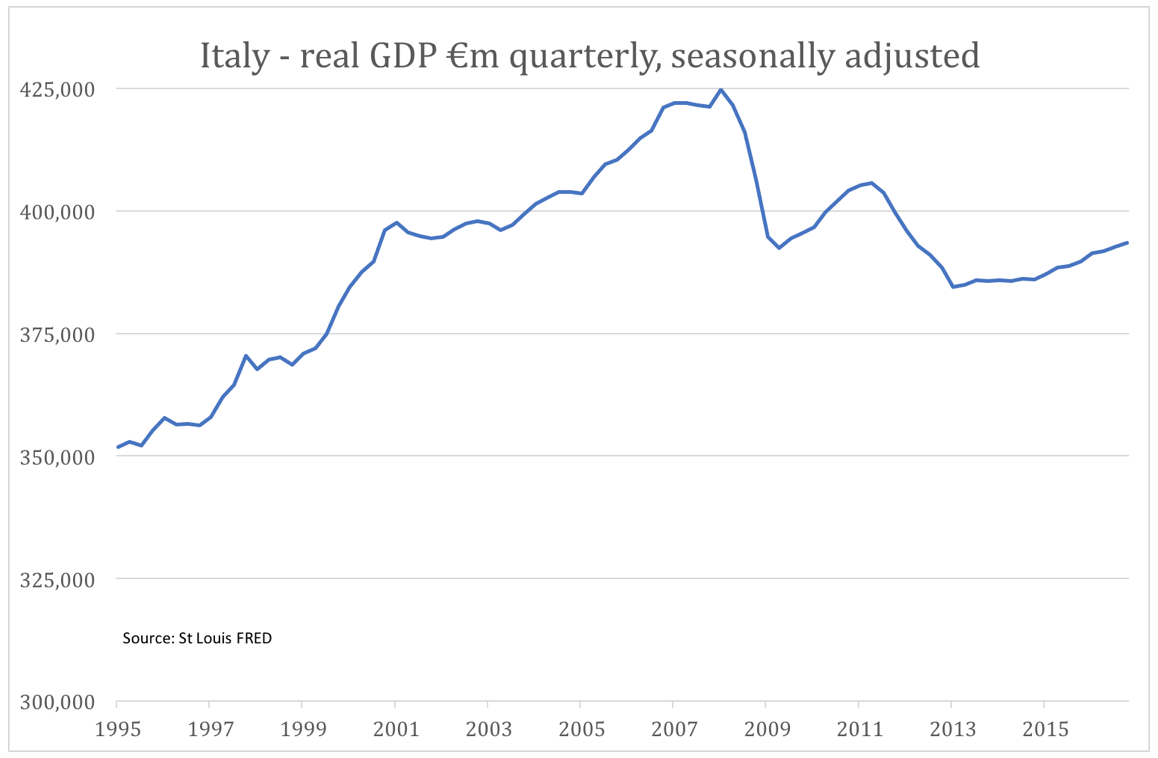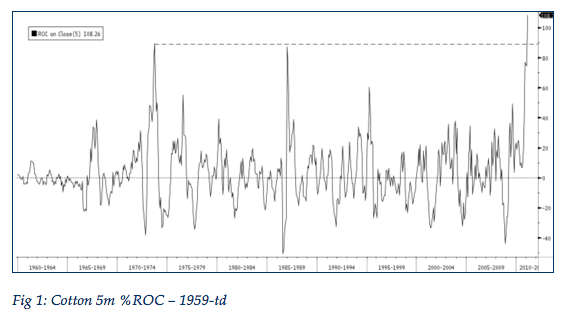There is a well-worn conundrum told about a stranger, who walks into the hotel in a remote, sleepy village in Mexico, and reserves a room for the night, paying 1,000 pesos in advance. The innkeeper rejoices at this unexpected turn of events, for the village is remote, few people have any reason to go there, and there is very little money. The innkeeper goes to the village butcher, to whom he owes 1,000 pesos, and discharges his debt. The butcher takes the 1,000 pesos and pays it to the farmer, who supplies him with his meat for which he owes the same amount. The farmer hands this money over to Maria, which he in turn owes for her services. Maria, who is the entertainment centre for the village’s men, then goes to the innkeeper and pays off her bar bill, incurred as a necessary expense of her business, and which, as you might have guessed amounts to 1,000 pesos.
Finally, the stranger returns, tells the innkeeper his plans have changed, and demands his 1,000 pesos back. He gets his money, the innkeeper, butcher, farmer and Maria have cleared their debts, and life in this backwater is all fine and dandy.
The story takes a poke at economists, challenging them to explain where the fault lies. There is nothing wrong with it as far as it goes, being theoretically possible. Of course, in real life there are other users of the hotel-cum-bar, the butcher has more than one customer, the farmer sells his meat to other retailers, and Maria is unlikely to confine her services to one customer. The riddle is too simplistic.
Putting that to one side, we shall continue with the essence of the story. The mistake is to assume that Maria, the farmer, the butcher and the innkeeper resume their previous behaviour of providing their goods and services on credit. While it is possible that they will assume another stranger will turn up to bail them all out, it’s far more likely the innkeeper will demand cash for tequilas, as will Maria for her services for the farmer, and so on. The arrangement collapses with the withdrawal of credit, as do all credit arrangements.
The nineteenth-century French economist, Frederic Bastiat, had a different story about a broken window, which has gone down in history as the broken window fallacy. A shopkeeper’s son breaks a window pane, and the shopkeeper is consoled by those that witnessed the action, who tell him that glaziers would go out of business if windows were never broken. This line of reasoning must conclude that it is a good thing to break windows, because it causes money to circulate.
Bastiat’s point is there is what is seen, and what is unseen. Everyone can see the window pane is broken. The alternative use of the shopkeeper’s money was to spend the money wasted on what he really wanted. In Bastiat’s example, the shopkeeper might have replaced his old shoes or bought another book. This alternative to the broken window is unseen, and therefore takes no account of the productive use of the money wasted.
Even today, we find economists reassuring us that destruction has a positive aspect, because the reconstruction of destroyed and damaged property ensures employment. They then take the fallacy one step further, justifying the building of bridges to nowhere, and supporting other flights of government fancy. A construction project, decided by government on criteria other than usefulness, which it is ill-equipped to gauge anyway, is what is seen. What is not seen is the money collected in taxes to pay for it, that otherwise would have been deployed in a manner that ordinary people, left to their own preferences, would choose. And what people choose to spend their money on employs other people in making genuinely useful things, and is the true engine behind economic progress.
This is not to say that all government construction projects are a total waste. It must be admitted that some use can be found for them. But it is a hit-or-miss affair, and government always ends up wasting money. Bastiat’s is a different point from the use of credit to expunge debt in the Mexican village, but together they encapsulate the two most common fallacies behind modern economics.
Taking the Mexican story further, the government sees poverty in the village, and subsidises local businesses like the hotel, perhaps in the name of promoting tourism and regional employment. Irrespective of whether the promotion succeeds, the good news is that Maria can now pay for her drinks, because she is paid by the farmer, the farmer is paid by the butcher who is paid by the innkeeper, who is subsidised by the tourist board.
Unfortunately, experience tells us that the innkeeper is unlikely to fulfil the government’s expectations of providing enhanced services for tourists. It is more likely the subsidy will begin to be a continuing obligation for the government, and the innkeeper will see it as his rightful due. And if the government realises money is being wasted, there is always another politician promising to keep the subsidy going. This brings us to a further (unseen) consideration: why should someone who never even heard of this village pay taxes to keep Maria in tequilas?
It might strike the reader as odd that modern economists perpetuate the Mexican story on a grand scale, but it is true. Keynes fell for it with a twist, and where Keynes went others followed. He assumed that consumption financed by extra money or credit would continue stimulating indefinitely, except to the extent that money was put aside as savings, which was the twist. For the layman trying to understand what Keynes tried to tell us, it helps if you know his objective, which basically is Maria gets her tequilas in perpetuity.
Of course, if any of the other three actors is inconsiderate enough to save some money for a rainy day, Maria will end up with fewer tequilas. Therefore, the innkeeper will need more money from the government. This is the basis of the neo-Keynesian criticism of saving.
Keynes appeared ignorant about what he was really describing, which is how new money is absorbed into an economy. His error was to disregard the price effect. In our Mexican village, the innkeeper, given his tourism subsidy, is told by the experts from the tourist board to improve his menu, by cutting back on the sweet potatoes and increasing the meat portions. Therefore, his demand for meat rises, and the butcher will need more supplies from the farmer, who only has a limited quantity of cattle, sheep and goats. He charges the butcher more. The butcher increases his prices to the innkeeper, and he in turn recovers it by charging Maria more for her tequilas.
Maria sees the cost of plying her trade at the hotel rising, so naturally wants more money from the farmer for her services. So, what started as new money entering the community through the innkeeper’s tourist subsidy leaves no one better off, because it just drives up prices.
In a small isolated village, the impact of extra money on its economy is easy to visualise. In a larger economy, the effect is the same. Being spread between more consumers, traders and producers, it is less obvious, takes longer to be fully absorbed, but nonetheless the price effect neutralises the extra money.
Richard Cantillon first described how the introduction of new money drove up prices as it was spent in his Essay on the Nature of Commerce in General, written in about 1730. In economic jargon, he described the intertemporal effect of monetary inflation on prices, something that is never considered by mainstream economists today. This was where Keynes erred. His mistake was to think the dispersion of new money into the economy was a multiplier effect, which it is not. It is merely the course new money takes as it drives up prices. His mistake was to disregard the price effect.
Central to getting this all wrong was Keynes’s dismissal of our old friend, Say’s law, which is based on the division of labour. Say’s law states that we produce things to buy the things we need, money being no more than the temporary storage of our labour. It goes without saying that if a person produces things no one wants, or does not want them enough to be produced profitably, that producer in turn cannot acquire the things he or she needs or wants in his or her role as a consumer. This is why all producers must dance to the consumer’s tune. Therefore, production always equals the sum of consumption plus savings (deferred consumption), assuming there is no overall change in the desire to hoard money.
Of course, it is possible to fabricate demand by expanding the quantity of money. But for this to work, people must be tricked into believing the demand is genuine. Unfortunately, artificial demand always ends up debasing the entire stock of money, that temporary storage of our labour, so that it buys less. Cantillon showed us how. Why any economist thinks you increase the general level of prosperity, the objective of expanding credit or printing raw money, by devaluing everyone’s output is beyond cogent reason.
This is where modern economists have arrived with their ill-founded beliefs. They are confused by a simple story of village folk deep in the hinterlands of Mexico, which is why the riddle has its appeal. They fail to understand the difference between a simple proposition, that which is seen, which is usually wasteful, relative to the unseen, which is the true path to economic progress. Instead, they retreat into irrelevant mathematics and the wishful belief that somehow the macro is different from the micro. They then devise computer models as if the economy is just a giant plumbing system.
Don’t expect to see anything resembling our cast of Mexican characters in their economic models. As for Maria, her contribution to village life is an apt metaphor for the relationship between modern economists and their ultimate paymasters.
See Keynes’s General Theory of Employment, Interest and Money, Chapter 10 “The marginal propensity to consume and the multiplier” (Sections 1 and 2).
For an intelligible criticism of Keynes’s multiplier, see Frank Shostak: https://mises.org/blog/how-magical-keynesian-multiplier



